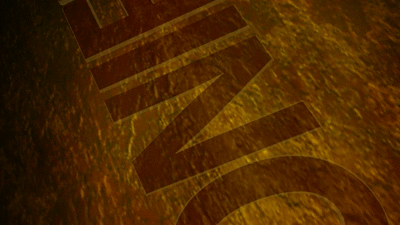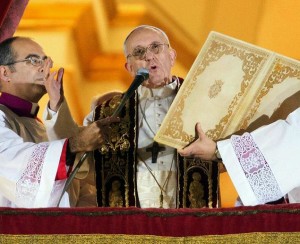
 Bergoglio, now Pope Francis, was selected as the first pontiff from South America, where there is a large and growing number of Catholics. The 76-year-old intellectual Jesuit will lead the world’s 1.2 billion devotees after serving as the archbishop to Buenos Aires.
Bergoglio, now Pope Francis, was selected as the first pontiff from South America, where there is a large and growing number of Catholics. The 76-year-old intellectual Jesuit will lead the world’s 1.2 billion devotees after serving as the archbishop to Buenos Aires.
Jorge Cardinal Bergoglio, a humble Argentine Jesuit, was elected Wednesday the new leader of the world’s 1.2 billion Catholics — and promptly took the name of the church’s most venerated saint to become the first Pope Francis. Bergoglio, 76, of Buenos Aires, is Latin America’s first Pope, the first Jesuit pontiff and the first leader of the Holy See from outside Europe in more than 1,000 years.
“You know that the duty of the conclave was to give a bishop to Rome. It seems that my brother cardinals went almost to the end of the world to get him. But here we are.” Francis said after he emerged onto the balcony of St. Peter’s Basilica for the first time as pontiff.
A view of the massive crowd present in St Peter’s as white smoke rises from the chimney on the roof of the Sistine Chapel. The historic moment came after just five rounds of voting from the 115 cardinals, who sequestered themselves into the Sistine Chapel Tuesday night — and sent up black smoke twice before the telltale white puffs billowed over the chapel and bells tolled all over the world.
“Habemus papam! — We have a Pope!” — Jean-Louis Cardinal Tauran announced to the crowd of thousands in St. Peter’s Square an hour later. Francis then emerged, having shed his birth name, gazing upon the throngs with a serene — some would say anxious — look on his face. His first act as pontiff was to ask the crowd to pray for him. Francis is seen as a skilled, humble administrator who helped modernize the Argentine Catholic Church.He will have to apply those skills to a deeply troubled global church facing both internal and external challenges. Even his selection of the name Francis — alluding to the saint who extolled the virtues of a life of poverty — hints that he may try to remedy the Vatican’s reputation for fiscal mismanagement and extravagance.
The election of the first Latin American also served as an acknowledgment that the church’s most important constituency was moving away from its historic base in Europe and into the developing world. “More than half of the world’s Catholics live outside of Europe, and more than half of them live in Latin America,” said Matthew Bunson, senior fellow at the St. Paul Center for Biblical Theology in Steubenville, Ohio. “The church in that part of the world has matured to the point that it has produced the supreme pontiff for a truly global Catholic community.”
It was unclear how Bergoglio reached the two-thirds majority — 77 votes — threshold in the fifth round, and it may remain that way forever. The cardinals take an oath of secrecy when the conclave begins. His election was followed by traditional ceremony. After the cardinals tallied the 77th vote, Giovanni Battista Cardinal Re, the top-ranking cardinal under the age of 80, asked the would-be Pope in Latin, “Do you accept your canonical election as supreme pontiff?” When Bergoglio accepted, he was then asked, “And by what name do you want to be called?”
He chose Francis apparently after St. Francis of Assisi, who renounced worldly possessions and preached a gospel of poverty. That’s when the ballots were burned, sending the crowd — where seemingly every country was represented — into a frenzy. Cheers of “Viva il Papa!” and “Praise the Lord!” were shouted in dozens of different languages as the new Pope was escorted into the “Room of Tears,” where he donned the white papal vestments for the first time. It is typically a solemn, weepy affair.
He had a brief prayer ceremony with the cardinals, and each one pledged his allegiance to the new leader. Handlers had put out a raised chair for the new pontiff, but he didn’t use it.“He met with each of us on our own level,” Timothy Cardinal Dolan said in an emotional press conference after the vote. “He didn’t go up on the platform to sit in the special chair, he just stayed down and greeted each of us.” Then, Francis was finally allowed a final moment of solitude in the Pauline Chapel of the Apostolic Palace before addressing his flock.
In divine fashion, the dreadful downpour stopped moments before the Pope appeared.“The rain stopped,” said a wide-eyed Christian Irdi, 29, who is studying for the priesthood in Rome. “Just throwing that out there! “The whole world is watching this, and we are here!” the Aussie added. Francis’ predecessor, “Pope Emeritus” Benedict, had been elected on the fourth ballot in 2005, and was considered a clear favorite going into that conclave. Indeed, Benedict XVI’s decision to resign — the first Pope to do so in 600 years — was considered a sign that he was too infirm to handle the problems threatening the church.
In the weeks following Benedict’s stunning announcement, a growing chorus of cardinals called for reform of the Curia — the Holy See’s hopelessly convoluted bureaucracy.Meanwhile, the church’s moral standing in much of the Western world has suffered under a Biblical flood of sexual abuse allegations. Only days before the start of the conclave, England’s Keith Cardinal O’Brien resigned after admitting his sexual conduct “had fallen below the standards of the church.” And Tuesday — as the cardinals began deliberating — the Los Angeles Archdiocese and Roger Cardinal Mahony entered into a $10 million settlement with four California men who claimed they were victims of abuse. Nevertheless, the world welcomed Francis with open arms.
“As a champion of the poor and the most vulnerable among us, he carries forth the message of love and compassion that has inspired the world for more than 2,000 years — that in each other, we see the face of God,” President Obama said in a statement. He was meeting with Republican lawmakers when the news was announced. Republicans said Obama was handed a note by an aide, then revealed to the GOP members that white smoke had appeared at the Vatican. “We were all very excited,” Rep. Michael Grimm (R-S.I.) recalled.
Back in St. Peter’s Square, the celebration was underway, with Argentines leading the charge.“Someone said he was Argentinian — oh, my God, we started to cry!” said Macaela Majorel, 18, who was backpacking with her friends through Europe. “Now we’re going to party — we’re going to party for the Papa!” Francis won’t be doing any partying — instead, he’s getting right to work. He will celebrate his first Mass as Pope in the Sistine Chapel Thursday, and will be installed officially as Pope on Tuesday, according to the Vatican’s spokesman, the Rev. Federico Lombardi. He’ll also visit with his predecessor Thursday, heading to Castel Gandolfo to meet the now-Pope Emeritus Benedict.
It’s unclear what style Francis will have as Pope. In Argentina, he was noted as a conservative who nonetheless angered some of his fellow church leaders by urging them to help the poor and baptize children born out of wedlock.A Jesuit taking the papal name Francis is a gesture of reconciliation within the church.Historically, the Jesuits and the Franciscans have been Catholic rivals, especially as the church spread the gospel — mostly by force — in the New World.
Now, however, the Jesuits and Franciscans are mostly divided by their “style” and “basic orientation,” Prof. Terrence Tilley of Fordham University said. Where the former is more intellectual and invested in the Vatican’s evolving decrees, the latter focuses on the religious purity of poverty.
“Jesuits tend to run universities that are fairly academically rigorous,” Tilley said. “Franciscans tend to work in the missionary field.” Another Argentine woman Dolores — who would not give her name due to her anxiety about unrest at home — traveled with her husband and five children to Rome shortly after Benedict announced his resignation. She praised Francis, who she said was known in Argentina for his modest lifestyle despite his status in the church. “He’s a very down to earth cardinal,” she said. “He’s very near to the people and humble of heart. I think he will bring great things to the church. This is an historic day.”
New York Daily News, Christina Boyle